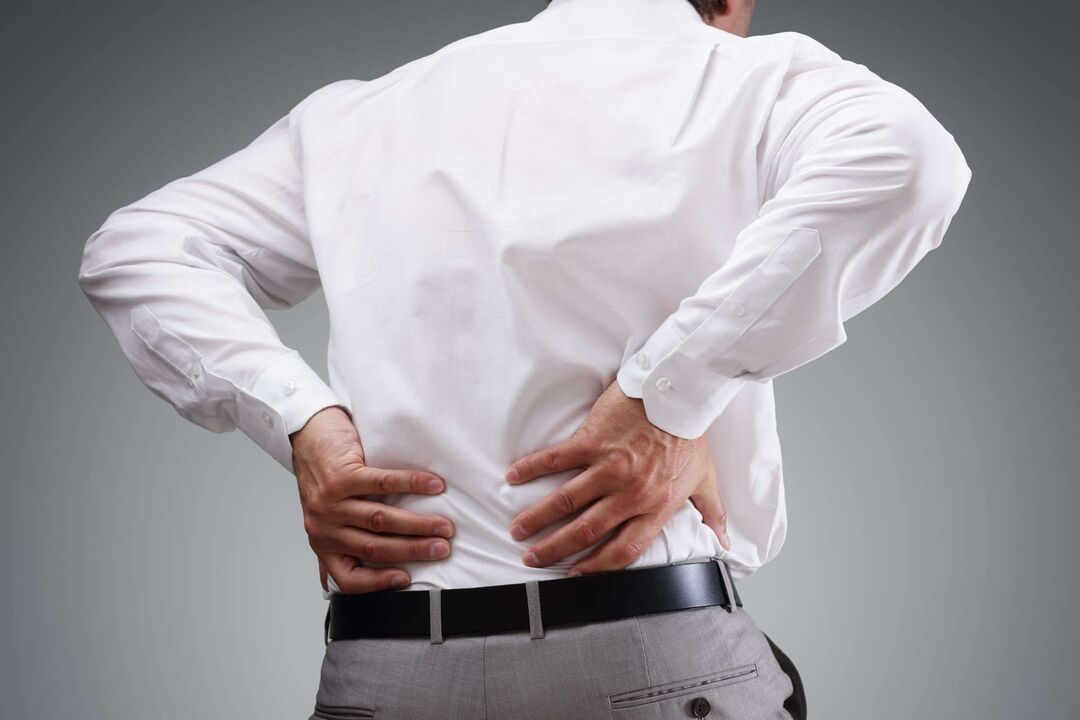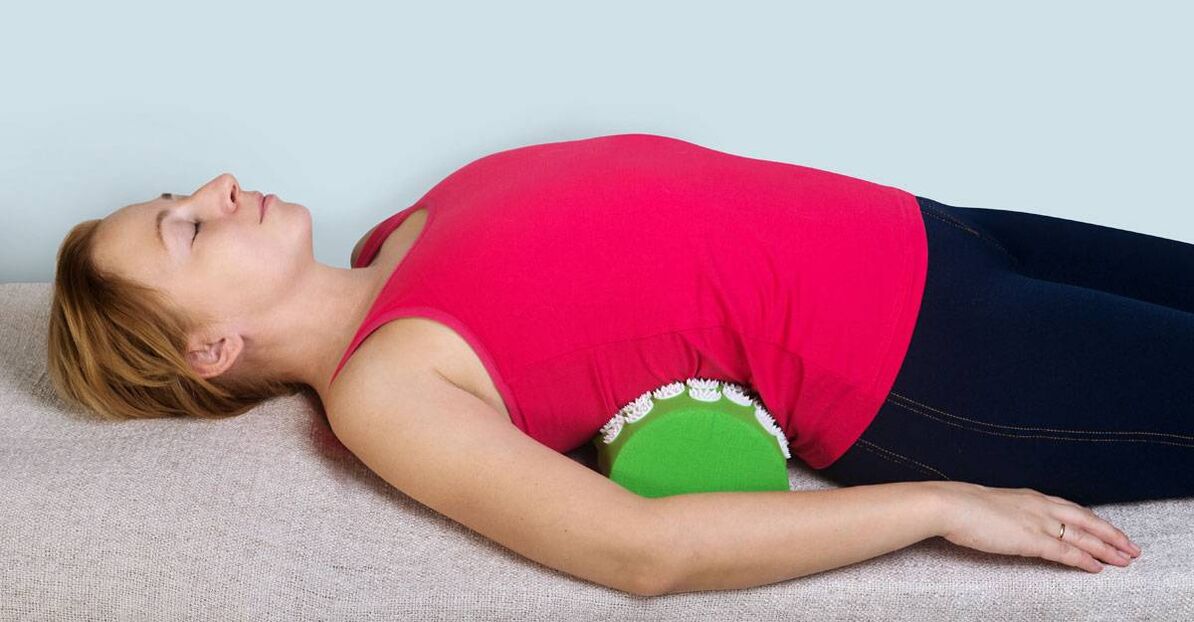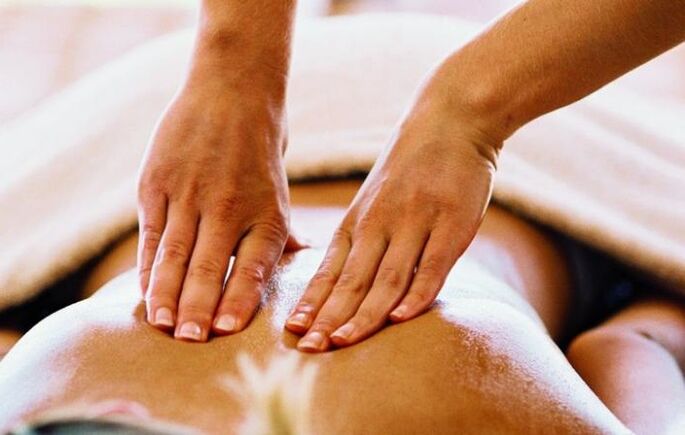With osteochondrosis of the spine, the bone and cartilage tissue of one or more parts of the spine is destroyed. This disease is chronic and develops in almost all elderly people. This is due to the usual aging of the body.

The intervertebral discs are subject to atrophic changes, and at what age this occurs depends on many factors:
- Trauma;
- Diseases and overload of the spine.
Spinal overload includes:
- walk with your back bent;
- wrong sitting;
- features of the structure of the spine;
- insufficient nutrition of the tissues of the spine due to hereditary abnormalities.
In osteochondrosis, the core located between the intervertebral discs loses part of the water. This leads to metabolic disorders in the cell nucleus and access to various minerals and vitamins is impeded.
After a while, cracks appear in the disk, it becomes flat. Next, the nearby joints and ligaments are affected, causing tissue inflammation. Inflammation causes the adjacent vertebrae to be displaced. This is dangerous in the presence of radicular symptoms: pain along the affected nerve.
It is also possible for an intervertebral hernia to occur, and it in turn can cause compression of the spinal cord. Osteochondrosis is characterized by the appearance of osteophytes - bone growths on the vertebral bodies. These growths can compress the spinal cord and cause radicular syndrome.
Most commonly, the cervical and lumbar spine are prone to osteochondrosis.
Cervical osteochondrosis
Causes:
- sporting activities (weight lifting);
- Obesity;
- Metabolic disease;
- sedentary work (programmer, accountant, driver, etc. );
- Flat feet;
- Spinal injury;
- Hypothermia.
Symptoms
The main symptoms of osteochondrosis of the cervical spine are pain in the head and neck area. A person worries about a severe headache, neck pain radiating to the arm, pain in the sternum. The patient may complain of lumbago - the appearance of a sharp pain in the neck, muscle spasms and restricted mobility.
Also, when turning the neck, a person may hear a crunch. A person may experience numbness of the tongue and fingertips due to pinched nerves and blood vessels. The patient complains of decreased hearing and vision, high blood pressure and weakness of the arm and leg muscles.
Osteochondrosis of the breast
This type of osteochondrosis is quite rare. This is due to the anatomical structure of the thoracic spine. It consists of 12 vertebrae that are connected to the ribs by joints. At the front, the ribs are connected to one another by the sternum. In this way, an excellent framework is created from the spine, sternum and ribs, which protects the internal organs from various injuries.
The vertebrae in the thoracic region are low and have long spinous processes that lie on top of each other like a shingle. Because of this structure, this part of the spine has little mobility. The intervertebral discs of the thoracic region are rarely injured.
The reasons for the formation of this type of osteochondrosis:
- irrational load sharing;
- delayed nutrition of the intervertebral discs;
- sedentary work;
- the presence of scoliosis.
Symptoms
As with other types, pain is the leading symptom of thoracic osteochondrosis.
However, with breast osteochondrosis, the pain may be different. Dorsalgia - long-term discomfort and mild pain along the thoracic vertebrae. The pain can affect the cervical and lumbar spine.
Dorsago is one of the signs of thoracic osteochondrosis, where pain comes in the form of an attack. It is naturally intense, acute, causes breathing difficulties and leads to a restriction in muscle movement. In addition to pain, patients may experience chest numbness, impaired sexual function, heart, kidney, and stomach pain.
What is the risk of the thoracic region?
The spine is designed to narrow in the chest area, so hernias due to osteochondrosis quickly compress the spinal cord. This can easily lead to problems with the heart, pancreas, liver, and kidneys, as the rib cage is connected to all of these organs by nerve fibers. That is why it is very important to consult a doctor in good time. He will help you find out where the troubling signs of osteochondrosis come from and conduct competent treatment of the disease.
Lumbar osteochondrosis
Lumbar spine osteochondrosis occurs from weight lifting. There is usually a nucleus in the center of the intervertebral disc that contains a lot of water. The liquid makes the core easily compressible and a compression of 500 kg is required for it to break.
However, the disc affected by osteochondrosis becomes weaker and it only takes 200 kg to tear it. If a person weighing 70 kg lifts 15 kg of a load in a bent position, this is a load of 200 kg for the spine, the intervertebral disc can tear. Therefore, when lifting weights, the first symptoms of spinal osteochondrosis appear.
Symptoms
- pain in the lumbar region;
- Inability to move in the lower back;
- Sleep disorder;
- Irritability;
- Fatigue;
- Impossibility of meeting household needs;
- decreased sexual function in men;
- Violation of the menstrual cycle;
- cold foot syndrome.
With the transition of osteochondrosis to the sacral region, the patient develops pain in the kidney area and a violation of urination.
diagnosis
Osteochondrosis is treated by a neurologist. First he examines the spine and draws attention to the presence of scoliosis. After feeling it, the doctor can understand how affected the spine, tendons, and nerves are.
If osteochondrosis of the spine is suspected, the neurologist will refer the patient for further examination. This includes the passage of an X-ray examination, magnetic resonance imaging. A discography is carried out if there is any suspicion of destruction of the intervertebral disc. It is also prescribed to determine the degree of damage to the nerve tracts.
In general, it is very difficult to diagnose osteochondrosis of the spine. Finally, a person may complain of pain in the heart, liver, kidneys, pancreas, or sexual dysfunction. But with a thorough examination, an experienced doctor can suspect this disease and prescribe the correct treatment.
treatment
Osteochondrosis therapy is a very long and difficult process. In the acute phase, the patient needs the rest of the affected segment. If the cervical spine is affected, the patient should wear a Shants Fixation Cuff. When the lumbar spine hurts, the patient needs bed rest. It is best to take the patient to a hospital. Only there he will be able to fully comply with the assigned regime. Such a patient's bed should be hard. To do this, a wooden board is placed under the mattress.
Medication
As mentioned above, the main symptom of the disease is pain. Therefore, analgesics and nonsteroidal anti-inflammatory drugs are prescribed to the patient to relieve pain and other symptoms of osteochondrosis.
Unfortunately, long-term use of these drugs leads to damage to the lining of the gastrointestinal tract, and the patient develops the following symptoms:
- Nausea;
- to throw up;
- Stomach pain;
- a feeling of heaviness in the abdomen.
Stomach ulcers can also get worse or gastric bleeding can occur. Hence, you should consult your doctor before taking this medication. If the pain caused by osteochondrosis persists for 3 months, antidepressants are prescribed along with these drugs. In addition to their calming effects, they have been shown to be able to relieve pain.
All drugs can be classified as symptomatic therapy. They will help relieve pain, but they will not rid a person of the disease on its own.
Chondroprotectors are prescribed to restore intervertebral discs and cartilage. These drugs improve connective tissue metabolism and help restore cartilage. The medication is taken over a long period of time, an average of 4-6 months.
In addition to restoring tissues and improving metabolism, these drugs also have an analgesic effect. Another group of drugs necessary for spinal osteochondrosis are drugs that improve blood circulation, their use helps widen blood vessels, and when thioctic acid is taken in combination with it, a person's nerve cell metabolism improves.
As with any disease, patients need calcium supplements. It restores the activity of bone tissue, increases the strength of ligaments and tendons, and prevents osteoporosis - a disease associated with osteochondrosis.
physical therapy

A dosed load on the spine improves the patient's condition. However, you need to do the exercises extremely carefully. Physical education is contraindicated in the acute phase. Only when the pain sensation subsides can you practice a little.
Sport improves blood circulation in the spine and strengthens the muscles. The blood flow improves metabolism and the recovery of damaged intervertebral discs begins. But you also need to remember that the lessons must be carried out regularly, otherwise there will be no result.
Exercises for injuries to the cervical spine
- Lie on your back and straighten up. Place one hand on your stomach and the other on your chest and inhale, hold your breath for 10 minutes, then exhale and relax. The duration of the exercise is 3 - 5 minutes. You need to do it 3-5 times a day.
- Lie on your stomach and straighten your legs. Leaning on your stomach and legs, you need to raise your head and upper chest. Perform the exercise 3 - 5 minutes at intervals of 30 seconds.
- Lie on your back and bend your knees. Turn right and left in this position. Perform the exercise 3 - 5 minutes at intervals of 30 seconds.
Exercises for lesions of the chest region
- Lie on your stomach. Put your hands on the floor and bend back. Hold this position for 5-10 seconds. Perform the exercise 3 - 5 minutes at intervals of 20 seconds.
- Lie on your backRaise your head and legs ("boat"). Hold for 10-20 seconds. Perform the exercise 3 - 5 minutes at intervals of 20 seconds.
Exercises for lesions of the lumbar spine
- Lie on your back, bend your knees and bring them to your chest. Swing back and forth and roll from your back to your sacrum and back. Swing for up to 2 minutes. Then you need to calmly lie down and relax.
- You need to stand on all fours and bend as far as possible. Perform the exercise 3 - 5 minutes at intervals of 20 seconds.
- While standing, imagine spinning the tire for 2 to 3 minutes. Exercise 10 times a day.
surgery
In the absence of an effect of conservative treatment and the appearance of complications of osteochondrosis, surgical treatment is prescribed. Stabilizing the spine removes pressure on the spinal cord and roots. If a person has an intervertebral hernia, it is removed. Since this operation can damage the spinal cord and nerves, it is only performed for vital reasons.
Physiotherapy treatment
The appointment of physiotherapeutic procedures has a positive effect on the course of the disease and accelerates the recovery process. With osteochondrosis, it is allowed:

- Visiting a sauna or bath;
- swim in the pool;
- Massage;
- Paraffin therapy;
- manual therapy;
- Laser therapy;
- different baths;
- Mud therapy;
- Electrophoresis with anti-inflammatory drugs or muscle relaxants;
- Magnetic therapy;
- darsonval.
All of these procedures improve blood flow to the diseased area, allow muscles to relax, and relax the whole body. Physiotherapy procedures are prescribed during the rehabilitation period, when the patient is not disturbed by severe pain.
prophylaxis
Nobody is immune to osteochondrosis. After all, we all age and our whole body grows old with us. In order for the disease not to ruin your plans, you need to start exercising from a young age. Moderate physical activity improves blood circulation, normal metabolism. It also trains the muscles that protect the spine. To prevent osteochondrosis, each person should:
- eat right - vitamins and minerals necessary for the body;
- to refuse from bad habits;
- participate in physical education;
- not lazing around;
- protect your back from hypothermia;
- Do not lift objects that are too heavy;
- take a contrast shower and temper;
- Avoid stress.
It is especially important for people suffering from this disease to follow all recommendations, as its failure will make it worse. If you have back pain that does not go away for a long time, you need to see a specialist. Only a doctor can make the correct diagnosis and prescribe treatment.
Do not hesitate to visit the clinic, as it is better to treat the disease at its early stages. Also, don't self-medicate - each drug has its own contraindications that you may not be aware of. Strictly follow all the doctor's recommendations, and then the disease will soon recede!














































